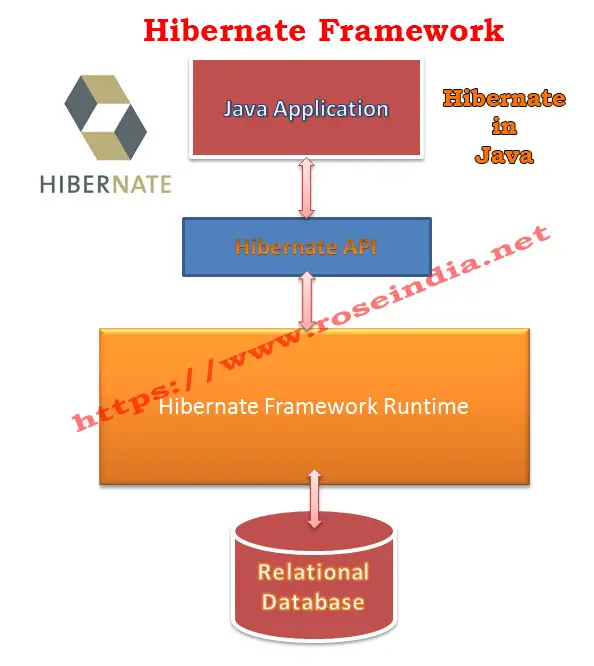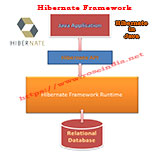Hibernate Java or Hibernate Open Source ORM tool in Java for fast development of database driven application
Hibernate is one of the most popular open source Object Relational Mapping tool in Java for writing database driven applications in Java. The development of Hibernate was started by Gavin King back in 2001 as an alternative to EJB2 style entity bean. Since then this framework grown very fast and now Hibernate is used very extensively in the industry for enterprise application development.
Hibernate in a Java is a Java based framework for data access layer development which simplifies creation of Java application that interacts with the relational databases. The Hibernate framework is released as an open source framework and it come with features like lightweight framework, ORM (Object Relational Mapping) tool, ease of development and maintenance. Hibernate is an ORM tool which can be used as a persistence provider for JPA (Java Persistence API).
Introduction to Hibernate in Java
Hibernate is a Java based high performance Object Relational Mapping tool which is used to interact with the relational databases. Hibernate is complete, highly robust, easy to learn and scalable framework to develop persistence layer backed with relational databases for enterprise applications. Hibernate framework can be used in console based, swing based and web applications. This framework was developed to automated task of database access using JDBC, it automatically generates the JDBC query in runtime to perform various database access functions.
This framework is mainly developed for Java, but its .Net port is available for the programmers using Microsoft technologies. Here we will only discuss the Hibernate framework in Java. Hibernate framework is easy to use framework for Java developers which hides the JDBC complicity from Java developers and reduces the application development time.
The Hibernate Object/Relational mapping (ORM) tool provides an easy way to map the Java Entity classes to the relational database table. Java programmers can use the API provided by this framework to perform the CRUD operations in a object relational way.

Hibernate framework is a very intuitive framework that gives developers an easy way to map the Java object structures to the relational database tables.
The ORM framework eases the development of programs to store the data from Java object instances into the persistence data store such as Oracle or MySQL. The important point here is that this framework is database independent and the program can be ported to another database store. For example you can develop the program for Oracle database and then it can be easily run against the MySQL database.
Features of Hibernate ORM framework in Java
Hibernate is big framework yet easy to learn and use in the project. That's why this framework is so popular among Java developer for enterprise application development. Now we are discussing the features of Hibernate framework and understand why this framework is so popular among Java developers.
Here are the top features of Hibernate framework:
- Hibernate framework automatically generates the SQL queries
necessary for performing the operations against the relational
databases. Hibernate framework completely takes care of
generation of SQL queries in runtime for database operations.
- Hibernate is database independent and it internally
implements the necessary dialects for different database
servers.
- It supports the fast development of applications with easy
coding of persistence layer in database driver project.
- Hibernate supports transaction management and it can also generate the primary key automatically for the new row.
Disadvantages of Hibernate Framework
Hibernate framework comes with lot of functionality that helps developer to develop complex application fast but still there are some disadvantages of this framework. Java developer must know the disadvantages of Hibernate framework.
What are the Disadvantages of Hibernate?
After learning the various advantages of highly popular Hibernate ORM Framework, we will see the disadvantages of the framework. These disadvantages can be a limiting thing on certain projects, so developers should know it. Here you will see What are the Disadvantages of Hibernate?
Let?s see the major disadvantages of Hibernate framework in Java
Large Collection of API: Hibernate framework comes with a large set of API for developing persistence layer of the application. Learning all these API is not an easy task and it takes time for developers to learn these. So, learning these complex API takes time and it's difficult to learn all the API of Hibernate.
Difficult Debugging: Sometimes it becomes debugging the application and performance time to meet business requirements. It is much easier to debug JDBC applications as compared to the persistence layer developed in Hibernate framework.
Hibernate is Slower than JDBC: Hibernate generates SQL queries in runtime and it is little slower than the pure JDBC program.
Hibernate is not good for Batch processing applications: Hibernate framework is not good for developing batch processing applications and it is advisable to use a pure JDBC program for such applications.
Hibernate is not suitable for small size projects: Hibernate comes with it's own runtime time thread and other bulky libraries, it is just suitable for highly transactional applications. If you are developing a very small application with just a few tables you should not use Hibernate, rather you can use pure JDBC for such applications.
For complex data types Hibernate is slow: Sometimes it is
required to work with complex data types and in such scenarios Hibernate does
not perform well. For example Hibernate does
not allow well to insert multiple objects in the sample table with a single
query. In such scenarios it generates multiple queries which slows the
performance of the application.
High Learning curve: Hibernate is a big library and it takes a lot of effort to learn it well. Initially it is easy to start with but for learning and practicing advanced concepts it takes time. The learning curve of this framework is high and takes a considerable amount of time.
Hibernate is a little bit slower than pure JDBC: The Hibernate framework generates a lot of SQL queries in runtime which slows the operations as compared to pure JDBC programs. But there is negligible effect on the program performance. Various caching mechanisms are used by Hibernate to actually increase the performance of the application.
How to learn Hibernate Framework?
Hibernate is popular ORM tool used in Java programming and if you are planning to make your career in Java then learn this ORM tool. Learning Hibernate is little difficult but with the help of our tutorials you will be able to get started with Hibernate quickly. Subsequently you can work on your project and keep on learning advanced topics of Hibernate step by step. Most of the time you will find some challenges in your project and you will have to explore Hibernate in more detail. Almost all the developers learn in-depth concept while working on the project.
Here are the pre-requisites for getting started with the Hibernate framework:
- SQL
- MySQL
- JDBC
So, before starting Hibernate framework programming you should have experience in SQL, MySQL (or any other database) and JDBC.
Here the tutorials to learn Hibernate framework
We have large collection of tutorials on Hibernate framework which will teach you this framework from beginning. Check out following tutorials:

